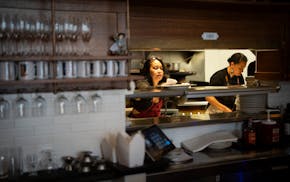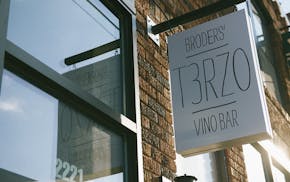It's been said that the average life span of a restaurant is 10 years. A decade is relatively easy to define: It's an epoch of fashion choices, artistic styles and the average restaurant lease length.
But sometimes, a restaurant rises above to become a destination that's stitched into the fabric of our specific place in the world.
"We are a place that had such humble beginnings," said James Beard Award-winning chef Alex Roberts in the dining room of his restaurant Alma. "Going back 25 years and saying we want to do contemporary American dining, what even is that?"
If we're lucky, these special restaurants break through the murky waters of fickle food trends, financial vertigo and the multitude of unpredictable factors that can affect their day-to-day existence and root in the hearts and minds of a larger community.
In the years since Alma opened, it has spawned several other businesses and continues to define an era when "American food" became a cuisine tied to seasonal ingredients from local farms. Now, from the vantage point of modern dining, it's clear to see when that dining style became commonplace. But at the time, in 1999, it was just another dream realized, hoping to find an audience.
Every person who loves a place in the food world has those restaurants: the ones we turn to time and again. There is a long list of these icons. But in this season of gratitude and great eating, we wanted to pay homage to some of the special restaurants celebrating major milestones in 2024.
For their anniversaries, we celebrate the people behind these beloved spaces, and the eras of Twin Cities dining they each had a hand in creating.
Jax Cafe, 90 years
When a restaurant has been around as long as Jax, even the memories have ancestors. Bill Kozlak, a descendant of the original owners of this post-Prohibition bar-turned-genre-establishing steakhouse, remembers being tended to in his little booster seat by a server who, just last week, celebrated her 50th year with the restaurant. And on Thanksgiving Day, one family will return for its 79th consecutive holiday meal at the corner of University and 20th avenues in northeast Minneapolis.
"It's a two-way relationship" between the restaurant and its wider community, Kozlak said. "Talk about being thankful."
When Jax opened in 1933, it was one of the first steakhouses in Minnesota, smashing the prewar dining dichotomy of either cafeterias or black-tie formality. It was also the first Minneapolis restaurant to take people outside to eat, on a patio that still stands as one of the best in the area, trout pond and all. It was even the first to have live lobsters in a tank in the dining room. "When you're around long enough, you have a lot of firsts," Kozlak said.
Steakhouses aren't exactly cutting-edge anymore; instead, most are designed as if they wished they were around at the start. Few can say they were. Jax can.
Plus, it really has the best parking lot in Northeast.
1928 University Av. NE., Mpls., jaxcafe.com
Matt's Bar, 70 years
In 70 years, the only thing that's really changed at Matt's Bar is the prices. The Jucy Lucy inventor (so they claim, but let's not get into that) is still reliably turning out onion-flecked, cheese-stuffed hamburgers to locals and tourists alike, U.S. presidents included.
By now, you'd think everyone Minnesotan would know the drill, but sometimes even the most die-hard Jucy Lucy fans need a Matt's Bar primer. On a recent afternoon, with a line out the door, several people breezed by in hopes of snagging a bar seat — and were promptly schooled. Here are your reminders:
Tip 1: Do not skip the line, no matter how much you want to, no matter how much it looks like you should.
Tip 2: Bring cash. We've never paid for our Jucy Lucy by check, but apparently it can be done. (There's an ATM in case you forget.)
Tip 3: Don't wear anything that requires dry cleaning; the smell of Matt's fryer and griddle comes home with you.
Tip 4: Be patient, not just for a seat but before you take that first bite, lest your tongue winds up with a cheese-inflicted burn.
Tip 5: Fries are extra, and you'll want to order them to munch on while waiting for the molten lava of cheese to cool to a reasonable temperature.
Tip 6: If you're planning to take a video of the cheese oozing out of the middle of the burger, order a backup for eating. Because once a Jucy Lucy is empty, there's no going back.
Tip 7: Slow down, look around and revel in the beautiful simplicity of a dive bar that has been doing the same thing right since 1954.
Founded by Matt Bristol in 1954, Matt's Bar is one of a long line of neighborhood eateries that fed the working class. These blue-collar bars were located where the customers lived and became community meeting points not usually known for their ability to influence the food conversation. That's where Matt's charted its own course. Today, there cannot be a conversation about the regional eccentricities of burgers without mentioning the (deliberately misspelled) Jucy Lucy.
3500 Cedar Av. S., Mpls., mattsbar.com
El Burrito Mercado, 45 years
The Silva family came to St. Paul as part of a wave of new immigrants that settled in the Twin Cities. Maria and Tomas loved their new home, but missed the flavors of Aguascalientes, their home state in Central Mexico.
At first they made trips to Chicago simply to get supplies like tortillas, dried chiles, cilantro and other items that used to be impossible to find at mainstream grocers. Their travels spawned a grocery store, panaderia, restaurant and eventually a family legacy that's a large part of the story of Minnesota's immigrant communities. It's a legacy that's carried on by the next generation.
"We just had our tamalada," said Milissa Silva their daughter who now owns the business with sister Suzanne Silva and niece Analita Silva. "Fifty percent of the people hadn't been to El Burrito before — and some had never even tried a tamal. That is my drive. That is my passion."
The family's story is just one of that era, when people new to the area contributed to the larger culinary conversation through restaurants serving family recipes.
"Being the first and only feels lonely and unseen. That's why to see this growth and our success is so exciting," said Silva. "People are being purposeful in their support of us. And so many are being more adventurous and exploring food that's new to them. We have always been here to support our fellow Latinos, but to have the larger community show up means so much."
El Burrito continues to expand its reach, too. This year the business debuted at the Minnesota State Fair, and it's popping up in downtown Minneapolis over the holidays as part of the Dayton's Project.
175 Cesar Chavez St., St. Paul, elburritomercado.com
Blue Plate Restaurant Co., 30 years
In 1993, Stephanie Shimp and David Burley opened up a new kind of neighborhood diner in St. Paul's Highland Park that peppered the menu with foods they loved to eat.
"There weren't many independent neighborhood dining establishments back then," said Shimp. "And they weren't places that served fresh, sometimes local food at reasonable price points. We have affordability and accessibility."
From the Highland Grill's humble beginnings, Blue Plate Restaurant Co. group was born. Shimp and Burley have gone on to create similar spaces for local diners across the metro, from Highland Park to Maple Grove and even at the Minnesota State Fair, with dishes that have become classics.
"We loved to eat pierogi at Kramarczuk's," said Shimp. "And I'd been to San Francisco and had tempura green beans, so we added those to the menu." Blue Plate restaurants were early to usher in dishes and trends that are now commonplace, like sweet potato fries, which were just beginning to trend in the late 1990s, and the local beer and craft cocktails wave.
"So many of us fell off of the D'Amico restaurant family tree," said Shimp. "Now we have so many other family trees. Alex Roberts, Gavin Kaysen's sprouting his own tree."
Not every restaurant they've opened has been an immediate success. "We were too early for Red Wing," she recalled. But learning those lessons allowed them to be leaders in the genre of locally owned restaurants taking root where people live. So much so that now communities actively recruit restaurants to bolster an area's livability.
"I think we contributed to the idea that every neighborhood deserves a great, independent restaurant to call their own. Something with fresh ingredients — good choices in beer/wine and spirits," Shimp said. "We helped shape that."
Highland Grill, Groveland Tap, the Lowry, the Freehouse, Three Squares, Longfellow Grill and the Blue Barn at the Minnesota State Fair; cqblueplaterestaurantco.com
Broders' Pasta Bar, 30 years
Some of Charlie Broder's earliest memories of working in his parents' restaurant was watching his mom package Christmas orders. "She was filling up all these boxes and we just became the helper elves."
The Broder siblings, Charlie, Thomas and Daniel, were steeped in the family's love of Italy and hospitality. In 1982, their parents, Molly and Tom, opened Broders' Cucina Italiana to share their love of Italian cuisine and proper East Coast-style pizza. In 1984, Broders' Pasta Bar delved deep into the cuisine of the Italian countryside and an appreciation for what can come from a little water and flour.
When the pasta bar opened, America's love of Italian food was becoming more nuanced and regional. The restaurant not only explored the country's cuisine it inspired, but also made it accessible to Twin Cities diners, with carefully selected wines and date nights where fans could enjoy the full experience of abundant pastas with fresh sauces and a bottle of great wine for a reasonable price.
The transformative dining experiences did more than just open the door to diners, but also to the next generation.
"Their love of Italy really did open up the whole world to us," said Charlie. While their paths to hospitality weren't immediately clear, the love for their parents' business thrived. That connection solidified in hard times: Tom Sr. died in 2008, and when COVID temporarily closed the restaurants, the sons stepped into ownership, each bringing different talents to the table.
The siblings continue to realize their parents' dream while infusing the modern-day Broders' with their talents and fresh perspectives on how to share an Italian feast.
5000 Penn Av. S., Mpls.; cqbroderspastabar.com
Alma, 25 years
When Restaurant Alma opened in 1999, chef/owner Alex Roberts had a radical idea of what his restaurant would be.
"We are a place that had such humble origins that it seems funny now. But we were looking to create something in a new way. When I said I wanted to cook 'contemporary American cuisine' there wasn't really an identifiable American cuisine," Roberts said. Italian or French cuisine? That was easy, but what it meant to make something local wasn't as easily explained.
He took what he'd learned leading kitchens in New York and applied it to Minneapolis, while forging relationships with the people who grew the food. That meant mornings at the farmers market, unpacking whatever was in front of him to create a menu for that day.
"We were striving for excellence, but also wondering, 'Is anybody going to show up?' " Roberts said.
People did, and to this day, it's a challenge to snag reservations on a Saturday night at the restaurant Roberts owns with his wife, Margo.
To the purposely unpretentious fine-dining restaurant they have added an adjacent cafe, built a fast-casual offshoot sibling in Brasa, and opened a boutique hotel stocked with apothecary products that Margo Roberts creates.
While the definition of Alma remains fluid, the restaurant's dedication to change is at its core. It started with the first menus that were dependent on what could be sourced that day, to its current space as a beacon of excellence, a neighborhood touchstone and a lovely place to spend a night.
The Robertses are also mentors in the community, serving those roles with a warmth that echoes the feeling of being inside the Alma space. Restaurant Alma was part of a wave of chef-run restaurants dedicated to seasonal cuisine, but continues to be a leader in showing what can be done with a relentless drive for grace and local eating.
528 University Av. SE., Mpls., cqalmampls.com
Manny's Tortas, 25 years
"I read in a Latino newspaper that they were going to open the first Latino mall on Lake Street," said Manny Gonzalez. There was an open call for restaurant ideas, inviting those interested to come with samples and ideas. "I knew people would put enchiladas, burritos, tacos." But Manny brought a taste of home: a Mexico City-style torta.
The mall would become Mercado Central, the first-of-its-kind collective of businesses and food stands on the corner of E. Lake Street and Bloomington Avenue S. When a second international market, Midtown Global Market, opened in the former Sears building, Manny's Tortas was one of the original tenants. It would be the beginning of a business trend where diners could roam through stands, order at stalls and dine in a common area. Today they're just called food halls, but the idea of acting as incubators for exciting, new restaurants remains.
The minute his idea was selected for a restaurant, he called his sister Vicky, who still lived in Mexico City working in business administration. Together, the two have built a lasting business.
"When we first opened, the only other place to shop for Mexican food was El Burrito," said Gonzalez. "Tortas were so popular all over Mexico, but they weren't so familiar to Americans."
The sandwich is glorious: crispy griddled meat packed with beans, onion, avocado, cheese, chipotle mayo and more onto toasty bread. But what the Gonzalezes have done through that one dish is even more impressive. Manny gained a reputation as the unofficial mayor of East Lake Street for his warm welcomes and advocacy for the area.
"It's really a beautiful avenue — you know, the way it connects to St. Paul," he said. "People who don't live here have ideas about south Minneapolis. I say you have to come! It's really beautiful."
At one point, Manny's Tortas had three locations on East Lake Street, but he's consolidated down to just the one inside Midtown Global Market (plus a popular stand at the Minnesota State Fair). That building is often credited as the city's first food hall, but there's a strong argument that Mercado Central kicked off the trend of collecting small food businesses in one casual setting.
It also marked an investment in the East Lake corridor that's still a vibrant part of the city, filled with Latin art and murals, activity and great eateries.
920 E. Lake St., Mpls., cqmannystortas.com
Bar La Grassa, 15 years
Even chef/owner Isaac Becker was pessimistic about his restaurant's chances when he opened Bar La Grassa in 2009. The location was too far from the core of downtown Minneapolis; there wasn't foot traffic. The only other nearby business was Bunkers, the music bar.
"It was kind of dark down here," Becker said. But Bar La Grassa brought the light to a strip of gloomy warehouses.
Today, the glowing red "BLG" sign is one of many beacons that draws crowds to the dining room for fresh pasta and luxurious lobster and scrambled egg bruschetta — and to the in-demand North Loop neighborhood at large.
It wasn't the first time Becker and spouse and co-owner Nancy St. Pierre bet on downtown. Five years earlier, they opened 112 Eatery on the opposite end of the neighborhood. Back then, it was the others who were pessimistic.
"Everybody I knew in the restaurant business said it was a terrible decision, but we didn't have a lot of money and it wasn't like I could just pick and choose the neighborhood or spaces I wanted, so we worked with what we had," Becker said. "And it worked out."
It sure did. 112 Eatery was conceived as a chef's destination: open late nights with food that Becker would seek out after a shift. The idea caught on, and diners clamored for foie gras meatballs and bacon, egg and harissa sandwiches. It opened the door to a different, uninhibited kind of cooking in Minneapolis, and Bar La Grassa followed right behind.
Today, Becker, a James Beard Award-winning chef, could have his pick of neighborhoods if he wanted. But what he wants is and always will be the urban heart of Minneapolis. He's glad everyone else has caught up.
800 Washington Av. N., Mpls., cqbarlagrassa.com
Spoon and Stable, 10 years
On a recent rainy night, chef Gavin Kaysen strode through his first restaurant, Spoon and Stable, and climbed up onto the bar to address the crowded dining room. He'd only done this once before, and that was on opening night, when there were no guarantees that the James Beard Rising Star Chef would stick the landing.
What followed was an evolution of the way the world saw the city's food scene, and a creative leveling up from Kaysen that would raise the bar on local dining.
"Now, we are seeing what this place has created and how that talent has gone off to create their dream to make our city, and state a better place to live and eat," Kaysen said in his speech. "Restaurants are special because of the community, and the community wins when they support these places."
He went from the Michelin-starred kitchen at Cafe Boulud in New York City to be a mentor, advocate and motivator in this city.
Through fine-dining events like the Synergy Series, which brings in globally renowned chefs for high-price-tag dinners as well as purposely affordable conversations, he's created master classes in understanding the humanity behind the industry's most well-known names.
Before all of that, Kaysen was a Bloomington native with a cache of pilfered spoons and a healthy dose of determination. In the decade since opening Spoon, he's worked tirelessly to promote the city, its dining scene and his industry, initiating text chains with other independent restaurant owners and opening his books to contemporaries to share how he made it all happen.
Kaysen's company has grown to include a partnership with Bellecour and Cooks of Crocus Hill, feeding professional athletes with Andrew Zimmern, his Michelin-worthy tasting menu restaurant Demi and Mara and Socca Cafe inside the Four Seasons.
It hasn't all been smooth sailing. "I went into this knowing there would be failure," he said. But, he says, the value is learning from those stumbles to stay on the road and carry on with the help of your stronger community.
211 N. 1st St., Mpls.,cq spoonandstable.com
Surly Beer Hall, 10 years
The craft beer scene in Minnesota is a given today, but it was far from it when Omar Ansari dreamed of opening a big brew hall in Minneapolis like he had seen in other states. The challenge was the law; Minnesota didn't allow breweries to serve pints on premises. Surly, which had a small operation in Brooklyn Center at the time, petitioned legislators and in 2011, won. The road to taprooms in Minnesota is still referred to as "the Surly bill."
Three years later, Surly's sprawling brew hall opened in an industrial corner of southeast Minneapolis. It was groundbreaking for more than the law it helped change. It brought beer and food pairings into a realm far beyond hot wings and a Miller High Life. The ground floor had elevated takes on approachable bar food, while the upper level Brewer's Table won accolades for beer-driven fine dining from chef Jorge Guzmán.
"Food is a huge component of what we do, and putting those two things together was the huge, big change," Ansari said. The Brewer's Table became the first restaurant to be cited in Food & Wine's Best Restaurants issue without coming into contact with a single grape.
But nobody said surviving for a decade would be easy.
Like most establishments in food and beverage that make it that far, Surly had a rocky, if rewarding, 10 years. Its head brewer resigned. The Brewer's Table closed. COVID put the groundbreaking brew hall out of business right at a pivotal moment for its staffers, who were in the process of organizing a union.
"When you're on this side of it, it's like, 'Oh, yeah, we got all through it,'" Ansari said. "But at the time, I remember sitting at home and just wondering, like a lot of us, 'What's going to happen? What are we going to do?'"
But the brew hall came back, and Surly's fans — especially of its Darkness Russian Imperial Stout — never left. It will celebrate its anniversary on Dec. 21, the darkest day of the year.
"There are ups and downs, certainly, through 10 years, but the whole point of the brewery was to bring people together," Ansari said. "On a Friday or Saturday, just seeing folks there with their families, multiple generations, getting together, that was the point. That's still here."
520 Malcolm Av. SE., Mpls., cqsurlybrewing.com

Can a prison be beautiful? And should it?

Immigrant home cooks shine in new Twin Cities dinner series

Broders won't reopen Terzo restaurant in Minneapolis after flooding

Afghan allies struggle in Minnesota after funding cuts: 'What will I do?'
